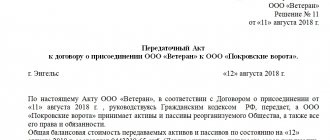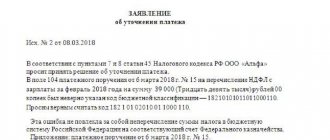Fulfillment of the obligation to pay taxes, fees, insurance premiums (penalties, fines) upon liquidation of an organization is regulated by Art. 49 of the Tax Code of the Russian Federation, and during its reorganization - Art. 50 Tax Code of the Russian Federation.
The Tax Code does not contain special rules establishing deadlines for filing tax returns for the last reporting (tax or accounting) period of activity of a reorganized or liquidated organization, which in practice raises questions on the part of taxpayers.
What are the procedures and deadlines for filing tax returns during the liquidation and reorganization of a taxpayer? We'll tell you in this article.
2-NDFL when changing the status of the company
As a rule, a company ceases to exist after submitting all reports in full, including 2-NDFL certificates for employees. After all, after the termination of activity, it does not have successors who could report on the data on tax accruals and withholding. Closing companies, submitting 2-personal income tax until the moment of liquidation, fill out certificates according to the usual algorithm - the name of the company is indicated in the line “tax agent”, and its details - in the appropriate fields provided.
When reorganizing (“reshaping” a company according to a selected criterion and registering it in a new capacity), the range of actions is wider. If, due to any circumstances, the company did not submit 2-NDFL before changes in status, the legal successor is obliged to report for it. This requirement has been in effect since the beginning of 2021 (clause 5 of Article 230 of the Tax Code). Therefore, the successor company in this case will submit information on the income of individuals twice:
- as a successor to the tax agent - for the period from the beginning of the year to the date of recorded reorganization;
- as a tax agent - for the time from the beginning of operation of the changed company until the end of the year.
Who fulfills the obligations to pay taxes during the liquidation (reorganization) of a taxpayer?
The obligation to pay taxes, fees, insurance premiums (penalties, fines) of the liquidated organization is fulfilled by the liquidation commission at the expense of the funds of the said organization, including those received from the sale of its property (Clause 1 of Article 49 of the Tax Code of the Russian Federation).
The obligation to pay taxes of a reorganized legal entity is fulfilled by its legal successor(s) in the manner established by Art. 50 Tax Code of the Russian Federation.
According to this article, the legal successor in terms of fulfilling the obligation to pay taxes is recognized as:
- in the case of a merger of several legal entities - the legal entity resulting from such merger (clause 4);
- when one legal entity is merged with another legal entity - the legal entity that merged it (clause 5);
- in case of division - legal entities arising as a result of such division (clause 6);
- when transforming one legal entity into another - a newly emerged legal entity (clause 9).
According to paragraphs 7 and 8 of Art. 50 of the Tax Code of the Russian Federation, if there are several legal successors, the share of participation of each of them in the performance of the duties of the reorganized legal entity to pay taxes is determined in the manner prescribed by civil law. When one or more legal entities are separated from a legal entity, succession in relation to the reorganized legal entity in terms of the performance of its obligations to pay taxes (penalties, fines) does not arise. In a number of cases provided for by these paragraphs, by a court decision, newly emerged (split-off) legal entities may jointly fulfill the obligation to pay taxes of the reorganized entity.
Changes to form 2-NDFL in 2021
To ensure the correct preparation of forms based on the right of succession and their subsequent submission to the Federal Tax Service, the legislator updated the 2-NDFL certificate. Since 2021, changes have been made to it, however, these do not affect the procedure for reflecting income, deductions and taxes.
Read also: Certificate 2-NDFL: new form 2019
Two new lines have been added to section 1 “Data about the tax agent”:
- “Reorganization/liquidation form”, where a code corresponding to the type of changes being made is entered:
– 0 – liquidation;
– 1 – transformation;
– 2 – merger;
– 3 – separation;
– 5 – connection;
– 6 – separation with simultaneous joining;
- “TIN/KPP of the reorganized company”
In the 5th section, in the field certifying the signature of the decryption of the signatory, an entry has been entered about the possibility of certifying the certificate by the legal successor. In the “tax agent” field of this section, the successor enters code “1”, and his representative - “2”.
Thus, new form fields are filled out exclusively by assignees. 2-NDFL certificates for the transformed company are submitted by them to the Federal Tax Service at the place of their territorial registration. At the same time, they indicate:
- OKTMO code of the reformed company;
- in the line “tax agent” - its name;
- in the field “TIN/KPP of the reorganized organization” - exactly the TIN/KPP of the reorganized company.
Let's look at filling out the 2-NDFL certificate using examples.
Tax period - quarter
A quarter is a tax period for the following taxes:
- VAT (Article 163 of the Tax Code of the Russian Federation);
- water tax (Article 333.11 of the Tax Code of the Russian Federation);
- UTII (Article 346.30 of the Tax Code of the Russian Federation).
If the tax period for the relevant tax is a quarter, the end date of the tax period is determined taking into account the provisions established by clause 3.2 of Art. 55 Tax Code of the Russian Federation:
| Period of termination of an organization through liquidation or reorganization | Last tax period |
| Until the end of the quarter | The period from the beginning of the quarter in which the organization was terminated until the day of state registration of termination |
| The organization was created and terminated in one quarter | The period from the date of creation of the organization to the day of state registration of termination as a result of liquidation or reorganization |
| The organization was created less than 10 days before the end of the quarter and terminated before the end of the quarter following the quarter in which the organization was created |
1-2.jpg
Example 2. Filling out 2-NDFL by the legal successor during reorganization
The company MIR LLC, located in Chelyabinsk (OKTMO 75712000, INN 7404215894, KPP 740445028) is being transformed by merging with Topol LLC from Yekaterinburg (OKTMO 65701000, INN 6612456456, KPP 661200012) from December 1 2021 This date is recorded in the state register termination of the activities of MIR LLC and the transfer of its assets by right of succession.
2-NDFL information for MIR LLC was not submitted to the Federal Tax Service. Topol LLC will report:
- as the legal successor of the transformed company, filling out 2-NDFL for the period from January 1 to November 30, 2021:
How can taxpayers determine their most recent tax period?
The concept of a tax period, the definitions of the first and last tax periods are given in Art. 55 Tax Code of the Russian Federation.
According to paragraph 1 of this article, a tax period is understood as a calendar year or another period of time in relation to individual taxes, at the end of which the tax base is determined and the amount of tax payable is calculated. A tax period may consist of one or more reporting periods, taking into account the features established by this article.







